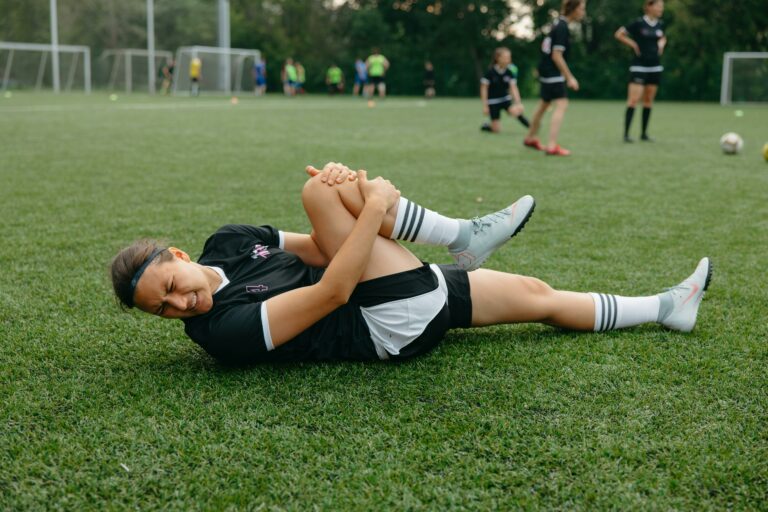How Chiropractic Care Prevents Sports Injuries in Athletes
Chiropractic care is a critical component in the prevention of sports injuries among athletes, focusing on maintaining spinal alignment and enhancing joint mobility. Through meticulous manual adjustments and individualized treatment plans, chiropractors address musculoskeletal imbalances, promoting peak physical function. This proactive approach not only prevents injuries but also enhances athletic performance by improving coordination and flexibility. Discover how these techniques empower athletes to sustain peak physical condition and achieve long-term success on and off the field.
Understanding the Role of Chiropractic Care in Sports
How does chiropractic care integrate into the domain of sports medicine, enhancing both prevention and recovery of injuries? Chiropractic care plays a significant role by employing chiropractic techniques aimed at injury prevention. Practitioners utilize manual adjustments and manipulations to improve joint mobility, thereby reducing the risk of injuries common in sports. This approach not only addresses musculoskeletal imbalances but also promotes overall physical resilience, an essential factor in athletic performance. By focusing on the body’s natural ability to heal, chiropractic care aids in quicker recovery from sports-related injuries. Additionally, the holistic model emphasizes patient-focused strategies, ensuring individualized care plans tailored to each athlete’s unique physiological needs. Consequently, chiropractic care effectively bridges the gap between conventional sports medicine and alternative therapeutic modalities.
Spinal Alignment and Its Impact on Athletic Performance
Ideal spinal alignment is essential for enhancing athletic performance across various sports disciplines. When the spine is properly aligned, it guarantees optimal spinal stability, which is imperative for efficient movement patterns and reduced injury risk. Proper alignment allows the nervous system to function without interference, facilitating improved coordination and response times. Chiropractors focus on maintaining this alignment through precise adjustments, promoting performance enhancement by allowing athletes to exert maximum effort with minimal energy expenditure. Such alignment contributes to a stable core, essential for balance and power. By addressing potential misalignments, chiropractic care aids athletes in maintaining peak physical condition, guaranteeing their bodies can withstand the demands of rigorous training and competition. Consequently, spinal alignment is a foundational element for achieving athletic excellence.
Enhancing Flexibility Through Chiropractic Techniques
Incorporating chiropractic techniques to enhance flexibility offers athletes a holistic approach to achieving peak physical performance. Chiropractic care emphasizes dynamic stretching and active release techniques to improve joint mobility and muscle elasticity. Dynamic stretching involves controlled movements that gradually increase in range and speed, preparing muscles for activity and reducing injury risk. Active release is a soft tissue technique focusing on breaking up scar tissue and adhesions, thereby improving flexibility and function. Chiropractors evaluate an athlete’s specific needs, tailoring these techniques to optimize flexibility and range of motion. By integrating these methods, athletes can experience improved performance and a reduced likelihood of injuries, underscoring the importance of a patient-focused, thorough strategy for athletic longevity and success.
Addressing Muscle Imbalances to Prevent Injuries
Addressing muscle imbalances is essential in preventing sports injuries, as these imbalances can lead to inefficient movement patterns and increased strain on the body. By employing a thorough assessment, chiropractors can identify specific muscle imbalances and tailor corrective exercise strategies to restore ideal function. This patient-focused approach not only enhances athletic performance but also mitigates the risk of future injuries, promoting overall well-being.
Identifying Muscle Imbalances
Recognizing muscle imbalances is essential in the field of sports medicine, as these imbalances can predispose athletes to a higher risk of injuries. Through precise muscle assessment, practitioners identify discrepancies in muscle strength and flexibility, which are critical in imbalance detection. This evaluation process involves a thorough examination of the athlete’s posture, range of motion, and muscle functionality. By employing a holistic approach, practitioners aim to understand the underlying causes of these imbalances, rather than merely addressing the symptoms. This patient-focused strategy guarantees that athletes receive individualized care plans, enhancing their performance while minimizing injury risks. Consistent monitoring and reevaluation are key components, allowing adjustments to be made as the athlete progresses, safeguarding long-term muscular health and stability.
Corrective Exercise Strategies
Implementing a range of corrective exercise strategies is essential in addressing muscle imbalances to prevent sports injuries. By focusing on tailored corrective exercises, practitioners aim to enhance joint stability, improve muscular coordination, and optimize functional movement patterns. A holistic approach considers the athlete’s unique biomechanics, ensuring that exercises are aligned with specific needs and goals. Key components include strengthening weak muscle groups, lengthening tight muscles, and improving proprioception. This targeted intervention fosters balanced muscle function, greatly contributing to injury prevention. Practitioners utilize assessments to identify imbalances and prescribe individualized exercise regimens, ultimately promoting resilience and performance. Through dedicated adherence to these corrective exercise programs, athletes can achieve a more harmonious musculoskeletal structure, reducing the risk of sports-related injuries.
The Importance of Joint Health in Athletes
Joint health is a critical component of an athlete’s overall physical well-being and performance. Maintaining ideal joint mobility is essential for executing precise movements required in sports. Athletes benefit from a thorough understanding of joint mechanics, as it supports injury prevention and enhances athletic longevity. Limited joint mobility can lead to compensatory movement patterns, increasing the risk of strains and sprains. In this situation, joint health is not merely about avoiding immediate injuries but involves a nuanced approach to sustaining long-term athletic performance. Chiropractic care emphasizes the alignment and function of joints, promoting both flexibility and stability. This holistic approach guarantees that athletes maintain peak physical condition, providing a foundation for improved performance while reducing the likelihood of sports-related injuries.
Proactive Injury Prevention Strategies With Chiropractic Care
Chiropractic care offers a proactive approach to injury prevention by focusing on enhancing athletic performance through tailored adjustments and therapeutic interventions. By improving joint flexibility, chiropractors help athletes achieve greater range of motion, which is essential for peak performance and injury avoidance. Additionally, reducing muscle tension through chiropractic techniques aids in maintaining muscle balance and decreases the risk of strains and other sports-related injuries.
Enhancing Athletic Performance
Athletic performance can be greatly enhanced through proactive injury prevention strategies, particularly with the integration of chiropractic care. This approach focuses on optimizing musculoskeletal function, thereby contributing to performance enhancement and injury resilience. Chiropractors employ techniques such as spinal adjustments and soft tissue manipulation to guarantee proper alignment and biomechanics. This holistic approach aids in maximizing an athlete’s physical capabilities while minimizing the risk of injury. Through individualized assessments and patient-focused care, athletes receive tailored interventions that address specific vulnerabilities. By identifying and correcting imbalances or misalignments, chiropractic care fosters a more efficient and resilient body. As a result, athletes can achieve peak performance levels with reduced likelihood of injuries, guaranteeing longevity and success in their respective sports disciplines.
Improving Joint Flexibility
Enhancing joint flexibility is a essential component of proactive injury prevention strategies within chiropractic care. By integrating dynamic stretching and mobility drills, chiropractors can greatly improve an athlete’s range of motion, which is critical for ideal performance and reduced injury risk. Chiropractic techniques focus on aligning the musculoskeletal system, ensuring that joints move freely and efficiently. This patient-focused approach encourages personalized protocols tailored to individual needs, promoting flexibility and joint health. Dynamic stretching complements these techniques by preparing muscles and joints for physical activity, enhancing flexibility without compromising joint integrity. Mobility drills further aid in maintaining joint health by increasing movement efficiency. Overall, chiropractic care employs a holistic strategy, emphasizing the importance of joint flexibility in safeguarding athletes from potential injuries.
Reducing Muscle Tension
Muscle tension reduction is a critical aspect of proactive injury prevention strategies in chiropractic care. By employing specialized muscle relaxation techniques, chiropractors address the underlying causes of tension, enhancing athletic performance and reducing injury risk. Through a holistic approach, chiropractors identify stressors that lead to muscle tightness and apply tension relief methods tailored to individual needs. Techniques such as myofascial release, trigger point therapy, and deep tissue massage are instrumental in alleviating muscle strain. These interventions not only promote relaxation but also improve circulation and flexibility, essential for maintaining peak muscle function. Patient-focused care guarantees that athletes receive personalized treatment plans, fostering resilience against injuries. Ultimately, chiropractic care supports athletes in achieving peak physical condition and minimizing downtime due to muscle-related issues.
Recovery and Rehabilitation: The Chiropractic Advantage
In the domain of sports recovery and rehabilitation, chiropractic care stands out as a holistic and patient-focused approach that offers distinct advantages. By integrating chiropractic techniques, practitioners address the biomechanical imbalances that often accompany athletic injuries. These techniques, including spinal adjustments and soft tissue therapies, facilitate injury recovery by optimizing joint function and enhancing neuromuscular coordination. This method not only accelerates recovery but also diminishes the likelihood of future injuries. Chiropractors emphasize individualized care, tailoring treatment plans to the unique needs of each athlete, thereby ensuring a thorough rehabilitation process. Additionally, their expertise in musculoskeletal health supports the restoration of peak physical performance, further underscoring chiropractic care as a pivotal component in the recovery toolbox for athletes.
Case Studies: Athletes Benefiting From Chiropractic Care
Although often overlooked, the impact of chiropractic care on athletes is both profound and measurable, as evidenced by numerous case studies. These studies document significant improvements in performance and a reduction in injury rates across various sports disciplines. For instance, elite athletes have experienced enhanced flexibility and faster recovery times due to chiropractic interventions. One notable case study involved a professional football player who reported reduced muscle tension and improved joint function, leading to prolonged career longevity. Another study highlighted a marathon runner benefiting from spinal adjustments that alleviated chronic back pain. Such athlete experiences underscore the holistic benefits of chiropractic care, emphasizing its role in supporting peak physical health and injury prevention. These findings illuminate the essential role of chiropractic care in athletic wellness.
Integrating Chiropractic Care Into Athletic Training Programs
The integration of chiropractic care into athletic training programs represents a strategic enhancement of athlete management strategies. Chiropractic techniques promote ideal musculoskeletal alignment, which is vital for injury prevention and recovery, thereby supporting sustained athletic performance. By focusing on spinal health and functional biomechanics, chiropractors contribute to holistic athlete care, addressing potential issues before they manifest as injuries. This patient-focused approach guarantees personalized treatment plans tailored to individual needs, enhancing overall effectiveness. Furthermore, incorporating chiropractic care into training regimens enables athletes to maximize their physical capabilities, potentially improving performance metrics such as flexibility, strength, and endurance. The synergy between chiropractic interventions and athletic training can lead to thorough health maintenance, ensuring athletes maintain peak performance and reduce the risk of sports-related injuries.
Frequently Asked Questions
How Often Should Athletes Visit a Chiropractor?
The chiropractic frequency for athlete wellness varies based on individual needs. Typically, athletes benefit from weekly to bi-weekly sessions. This holistic approach guarantees ideal alignment, enhances performance, and reduces injury risk, focusing on personalized care for sustained well-being.
Are There Specific Sports That Benefit More From Chiropractic Care?
Certain sports, such as football and tennis, benefit greatly from chiropractic care. This patient-focused, holistic approach can enhance tennis performance by improving flexibility and alignment while reducing football injuries through targeted spinal adjustments and muscle rehabilitation techniques.
Can Chiropractic Care Help With Mental Focus and Concentration in Sports?
Chiropractic care, through its holistic approach, can aid in focus enhancement and mental clarity. By optimizing neural function and reducing physical stressors, it supports athletes in achieving enhanced mental concentration and overall cognitive performance during sports activities.
What Qualifications Should a Sports Chiropractor Have?
A qualified sports chiropractor should hold a chiropractor certification and possess specialized training in sports injury prevention. Their technical expertise, holistic approach, and patient-focused care guarantee peak performance and reduced injury risk for athletes.
Are There Risks Associated With Chiropractic Care for Athletes?
Chiropractic safety for athletes involves minimal risks, though concerns exist regarding potential injury exacerbation or misalignment issues. A holistic approach, emphasizing technical expertise and patient-focused care, helps mitigate these concerns, ensuring athletes receive safe, effective treatment.

